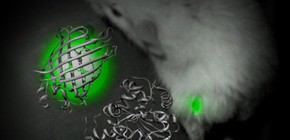
Development of the brightest luminescent protein to date
"Nano-lantern" allow visualization at single-cell, organ, and whole-body levels
Under the leadership of NAGAI Takeharu , Professor, Department of Biomolecular Energetics, Institute of Scientific and Industrial Research, Osaka University, HORIKAWA Kazuki , Associate Professor, National Institute of Genetics, HATSUGAI Noriyuki , Specially Appointed Assistant Professor, Graduate School of Medicine, Hokkaido University, and HIGUCHI Yuriko , Assistant Professor, Graduate School of Pharmaceutical Sciences, Kyoto University, a group of researchers have developed a luminescent protein, Nano-lantern, with a brightness increase of 10 times, through hybridization of a chemiluminescent protein and a fluorescent protein.
This group succeeded in real-time imaging of cancer tissues in living mice by marking cells with Nano-lantern. The group has also successfully developed Ca2+, cyclic adenosine monophosphate (cAMP) and adenosine 5'-triphosphate (ATP) indicators based on Nano-lantern. As these luminescent probes don't need external light, they will enable new discoveries that fluorescent protein-based probes could not achieve. Moreover, Nano-lantern and luminescent probes can be easily combined with optogenetic technology for regulating cell activity and protein function by light. For example, this technology allows operation and measurement of nerve action at the same time, making it possible to clarify mechanisms for higher nervous activities such as action, thinking, and memorization that have been difficult to do experiments on because of their complexity.
Abstract
The use of fluorescent proteins has revolutionized our understanding of biological processes. However, the requirement for external illumination precludes their universal application to the study of biological processes in all tissues. Although light can be created by chemiluminescence, light emission from existing chemiluminescent probes is too weak to use this imaging modality in situations when fluorescence cannot be used. Here we report the development of the brightest luminescent protein to date, Nano-lantern, which is a chimera of enhanced Renilla luciferase and Venus, a fluorescent protein with high bioluminescence resonance energy transfer efficiency. Nano-lantern allows real-time imaging of intracellular structures in living cells with spatial resolution equivalent to fluorescence and sensitive tumour detection in freely moving unshaved mice. We also create functional indicators based on Nano-lantern that can image Ca2+, cyclic adenosine monophosphate and adenosine 5′-triphosphate dynamics in environments where the use of fluorescent indicators is not feasible. These luminescent proteins allow visualization of biological phenomena at previously unseen single-cell, organ and whole-body level in animals and plants.

Figure 1
To learn more about this research, please read the full research report entitled " Luminescent proteins for high-speed single-cell and whole-body imaging " at this page of the Nature Communications website.
Related link
